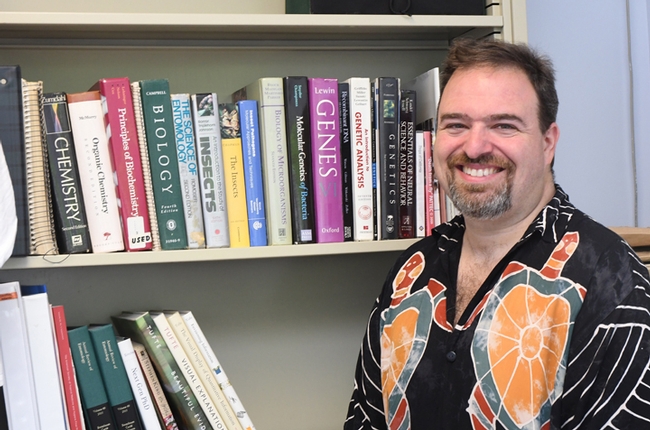- Author: Kathy Keatley Garvey
Tsetse fly expert Geoffrey Attardo, a medical entomologist and assistant professor with the UC Davis Department of Entomology and Nematology, is featured in a New York Times' article today (Feb. 12) on tsetse flies.
His work drew the attention of Pulitzer-Prize winning science writer Natalie Angier who penned the article, "Everywhere in the Animal Kingdom, Followers of the Milky Way" (subhead: "As scientists learn more about milk's evolution and compositional variations, they are redefining what used to be a signature characteristic of mammals.")
"Most female flies take a low-rent approach to parenthood, depositing scores of seed-sized eggs in the trash or on pet scat to hatch, leaving the larvae to fend for themselves," she wrote. "Not so the female tsetse fly. She gestates her young internally, one at a time, and gives birth to them live. When each extravagantly pampered offspring pulls free of her uterus after nine days, fly mother and child are pretty much the same size."
Then she quoted the UC Davis medical entomologist:
“It's the equivalent of giving birth to an 18-year-old,” said Geoffrey Attardo, an entomologist who studies tsetse flies at the University of California, Davis.
Attardo focuses his research on numerous aspects of the physiology of tsetse fly reproduction, with the goal to identify and understand key aspects of its reproductive biology. He joined the UC Davis Department of Entomology and Nematology in 2017 from tje Yale University School of Public Health, New Haven, Conn., where he researched tsetse flies in the lab of Serap Aksoy.
In terms of "fascinating physiological adaptations," Attardo considers the tsetse fly "one of the champions of the insect world!" As he explained to us in a 2017 news story: "In addition to being vectors of a deadly disease, Trypanosomiasis, these flies have undergone amazing alterations to their physiology relative to other insects. Some examples of this are their ability feed exclusively on blood, their obligate relationship with a bacterial symbiont, the fact that they lactate and that they give birth to fully developed larval offspring."
"The opportunity to study the adaptations these flies have made is like opening a toy chest for an insect physiologist. My work in tsetse has focused on the molecular biology underlying the adaptations associated with the development of lactation, symbiosis, male and female mating interactions/physiology and nutrient metabolism and mobilization.”
Attardo's published research is drawing national and international attention, as are his incredible images of tsetse flies. He won the 2010 Fogarty Grantee Photo Contest with an image of a tsetse fly. The Yale School of Public Health magazine featured his images on “An Eye for the Tsetse Fly.” The Los Angeles Times published his remarkable video (in 2014) of a tsetse fly giving birth. Also, see his portraits of the tsetse fly on Live Science, published in 2014.
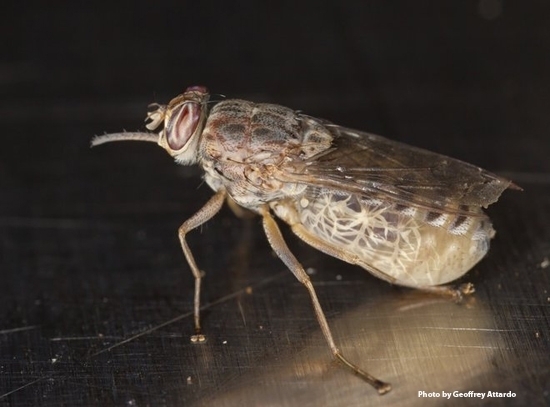
- Author: Kathy Keatley Garvey
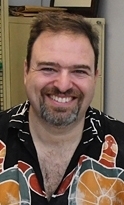
All will take place from 4:10 to 5 p.m., Wednesdays in 122 Briggs Hall.
The seminars:
Wednesday, Jan. 9
Brian Gress, postdoctoral fellow in the Frank Zalom lab, UC Davis Department of Entomology and Nematology
Title: "Host Selection and Resistance Evolution in Drosophila suzukii"
Host: Frank Zalom, distinguished professor of entomology, UC Davis Department of Entomology and Nematology
Wednesday, Jan. 16
No seminar today. (Seminar by Sarah Stellwagen, postdoctoral researcher, University of Maryland
will present her previously scheduled seminar on “Toward Spider Glue: From Material Properties to Sequencing the Longest Silk Family Gene” on April 24.)
Wednesday, Jan. 23
Jenita Thinakaran, UC Davis postdoctoral researcher based at the Shafter Agricultural Research Station
Title: "A Systems Approach to Managing Potato Psyllid in Relation to Its Alternate Hosts"
Host: Geoffrey Attardo, assistant professor of entomology, UC Davis Department of Entomology and Nematology
Wednesday, Jan. 30:
Laura Burkle, assistant professor of ecology, Montana State University, Bozeman
Topic: Wild bees, interactions with flowers
Hosts: Pollination ecologist Neal Williams, professor of entomology, and Maureen Page, doctoral student in the Williams lab, UC Davis Department of Entomology and Nematology
Wednesday, Feb. 6
Alan Hastings, theoretical ecologist and distinguished professor, UC Davis Department of Environmental Science and Policy
Title: "Stochasticity and Spatial Population Dynamics"
Host: Hanna Kahl, doctoral student in the Jay Rosenheim lab, UC Davis Department of Entomology and Nematology
Wednesday, Feb. 13
Antoine Abrieux, postdoctoral fellow, Joanna Chiu lab, UC Davis Department of Entomology and Nematology
Title: "Understanding the Molecular Mechanisms underlying Photoperiodic Time Measurement in Drosophila melanogaster"
Host: Joanna Chiu, associate professor and vice chair of the UC Davis Department of Entomology and Nematology
Wednesday, Feb. 20:
Alexander Raikhel, distinguished professor, UC Riverside
Title: "The Role of Hormone Receptors and MicroRNAs in Mosquito Reproduction and Metabolism"
Host: Geoffrey Attardo, assistant professor, UC Davis Department of Entomology and Nematolgoy
Wednesday, Feb. 27:
Lauren Esposito, faculty member, San Francisco State University, and assistant curator and Schlinger Chair of Arachnology at the California Academy of Sciences
Title: "Evolution of New World Scorpions and Their Venom"
Host: Jason Bond, Evert and Marion Schlinger Endowed Chair in Insect Systematics, UC Davis Department of Entomology and Nematology
Wednesday, March 6:
Monika Gulia-Nuss, assistant professor, biochemistry and molecular biology, University of Nevada, Reno
Topic: DNA Methylation in Ticks
Host: Geoffrey Attardo, assistant professor, UC Davis Department of Entomology and Nematology
Wednesday, March 13:
Stephen "Fringy" Richards, associate professor, Baylor College of Medicine, Human Genome Sequencing Center.
Topic: "Evolutionary Genomic Innovation Within the Phylum Arthropoda"
Host: Steve Nadler, professor and chair, UC Davis Department of Entomology and Nematology
Spring Break: March 20-27
For further information on the seminars, contact Geoffrey Attardo at gmattardo@ucdavis.edu.
- Author: Kathy Keatley Garvey
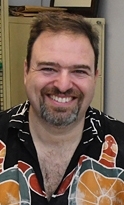
Coordinator Geoffrey Attardo, assistant professor and medical entomologist said that the seminars will take place on Wednesdays at 4:10 in 122 Briggs Hall, located on Kleiber Hall Drive. Exception: Arnaud Martin will speak on Friday, Oct. 19 at noon in 122 Briggs Hall.
Robert Page, provost emeritus of the University of Arizona and emeritus professor and chair of the UC Davis Department of Entomology and Nematology, has been selected the recipient of the Thomas and Nina Leigh Distinguished Alumni Award. He will give a seminar on on Thursday, Nov. 29 at the International House, 10 College Park, Davis. A reception begins at 3 p.m., followed by his 4 p.m. seminar, titled "In Search of the Spirit of the Hive: a 30-Year Quest."
The seminars for the fall quarter:
4:10 p.m., Wedneday, Sept. 26
Mark Hoddle, Extension entomologist and director of the Center for Invasive Species Research, University of California, Riverside, will speak on “Protecting California Agriculture from Invasive Pests: Biocontrol of Asian Citrus Psyllid in Urban Southern California."
Host: Geoffrey Attardo
4:10 p.m., Wednesday, Oct. 3
Daniel Karp, assistant professor in the UC Davis Department of Fish, Wildlife, and Conservation Biology: "Harmonizing Biodiversity Conservation with Agricultural Production Across Working Landscapes"
Host: Jay Rosenheim, professor, UC Davis Department of Entomology and Nematology
4:10 p.m., Wednesday, Oct. 10
Geoffrey Attardo, assistant professor, UC Davis Department of Entomology and Nematology: "Comparative Genomic Anaylsis of the Tsetse Fly: The Genetics of Lactation, Seminal Proteins and Other Unique Adaptations"
Noon, Friday, Oct. 19 (change from initial schedule of 4:10 p.m., Oct. 17)
Arnaud Martin, assistant professor of biology, George Washington University: "Do Butterflies Dream of Genetic Tattoos? Exploring the Genotype-Phenotype Map Using CRISPR"
Host: Geoffrey Attardo
4:10 p.m., Wednesday, Oct. 24
Naoki Yamanaka, assistant professor, UC Riverside: "A Membrane Transporter Is Required for Cellular Uptake of Ecdysone"
Host: Geoffrey Attardo
4:10 p.m., Wednesday, Oct. 31
Fred Wolf, assistant professor, UC Merced: "Drinking Drosophila and Drunk Drosophila: Genes and Circuits for Simple Behaviors"
Host: Joanna Chiu, associate professor and vice chair, UC Davis Department of Entomology and Nematology
4:10 p.m., Wednesday, Nov. 7
Lark Coffey, assistant professor in the Department of Pathology, Microbiology and Immunology, UC Davis School of Veterinary Medicine: "Zika Virus in Macaques, Mice and Mosquitoes: Contrasting Virulence and Transmissibility in Disparate Hosts"
Host: Geoffrey Attardo
Wednesday, Nov. 14
(No seminar; Entomological Society of America's annual meeting takes place from Nov. 11-14 in Vancouver, B.C.)
Wednesday, Nov. 21
(No seminar; Thanksgiving week)
Wednesday, Nov. 28
(No seminar)
4 p.m. Thursday, Nov. 29: Thomas and Nina Leigh Distinguished Alumni Seminar, Nov. 29
Recipient is Robert Page, Provost emeritus of the University of Arizona and emeritus professor and chair of the UC Davis Department of Entomology and Nematology. He will give a seminar on on Thursday, Nov. 29 at the International House, 10 College Park, Davis. A reception begins at 3 p.m., followed by his 4 p.m. seminar, titled "In Search of the Spirit of the Hive: a 30-Year Quest."
4:10 p.m., Wednesday, Dec. 5
Cindy Preto, recent graduate (master's degree in entomology from UC Davis, Frank Zalom lab) "Behavior and Biology of the Three-Cornered Alfalfa Hopper in Vineyards."
Host: Frank Zalom, distinguished professor, UC Davis Department of Entomology and Nematology
For more information on the seminars, contact Attardo at gmattardo@ucdavis.edu.
- Author: Kathy Keatley Garvey
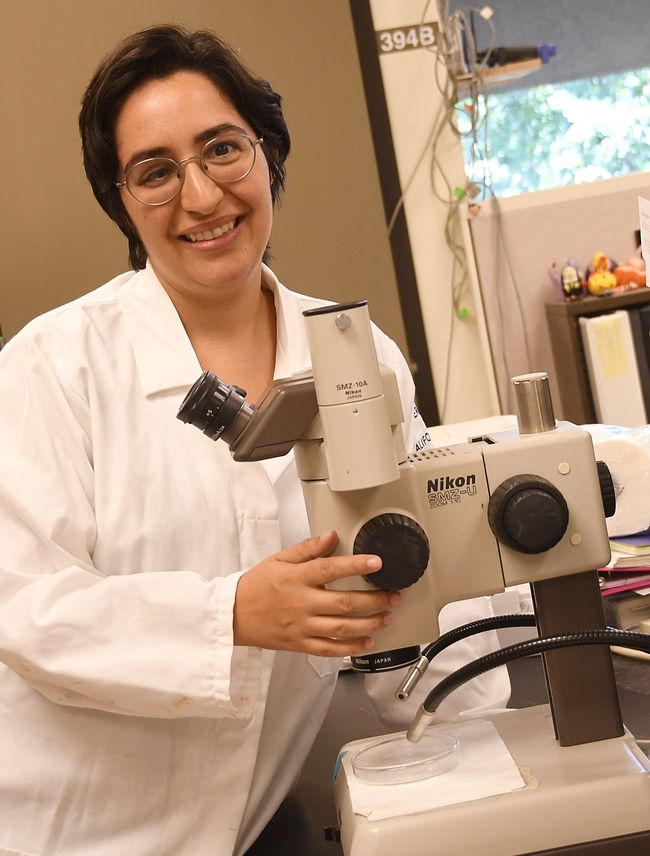
Both are seeking a doctorate at the University of California, Davis. They differ in that Winokur focuses her research primarily on the yellow-fever mosquito, Aedes aegypti, while Portilla's research involves Culex mosquitoes, which transmit West Nile virus and other diseases.
They are alike in that they share the passion of the late William Emery Hazeltine (1926-1994), who worked tirelessly in mosquito research and public health.
Hazeltine, a native of San Jose, was a U.S. Navy veteran who studied entomology at UC Berkeley and received his doctorate in entomology from Purdue University in 1962. He managed the Butte County Mosquito Abatement District, Oroville, from 1966 to 1992, and the Lake County Mosquito Abatement District from 1961-1964.
He was an ardent supporter of the judicious use of public health pesticides to protect public health, remembers Bruce Eldridge, emeritus professor of entomology at UC Davis and former director of the (now folded) statewide UC Mosquito Research Program. Eldridge eulogized him at the 2005 annual meeting of the American Mosquito Control Association (AMCA) as "a man who made a difference." The AMCA journal published his eulogy in its 2006 edition. (See http://entomology.ucdavis.edu/files/154217.pdf)
"Bill was a medical entomologist who had a varied career in the field of mosquito biology and control, but he will forever be remembered as a man who fought in the trenches of the pesticide controversy from 1960 until the end of his life, and who made the safe and efficient use of pesticides in public health a personal crusade," Eldridge said.
In his memory, his three sons--Craig Hazeltine of Scottsdale, Ariz., Lee Hazeltine of Lincoln, formerly of Woodland, and the late Jeff Hazeltine (1958-2013)—established the UC Davis Bill Hazeltine Graduate Student Research Awards, awarding the first one in 1997. Each year they travel to Davis to honor the recipients at a luncheon, timed with their attendance at a scholarship and fellowship celebration, hosted by Dean Helene Dillard, UC Davis College of Agricultural and Environmental Science.
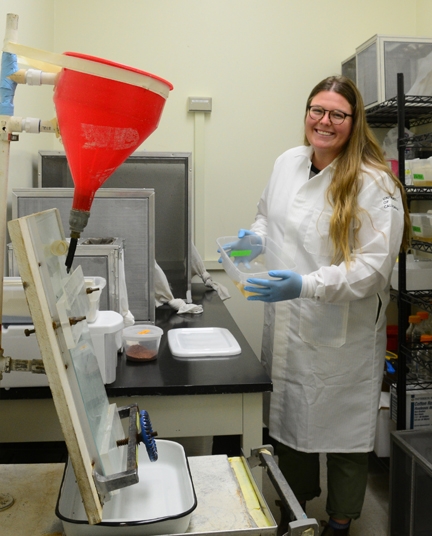
Winokur's funded project: “Identifying Aedes Mosquito Eggs Using Hyperspectral Imaging: a Rapid, Low-Cost, Non-Destructive Method to Improve Mosquito Surveillance and Control.”
Portilla's project: “The Management of Invasive Weeds and their Effects on Larval Culex mosquitoes.”
“Aedes aegypti and Aedes albopictus are mosquitoes capable of transmitting dengue, chikungunya, yellow fever, and Zika viruses,” Winokur explained in her application. “These species are invasive and present in California and continue to spread, increasing the likelihood of local transmission of these devastating viruses. Additionally, Aedes notoscriptus, an Australian mosquito whose vector competence for many viruses is unknown, has been detected in Los Angeles and is likely to spread in the state. Aedesmosquitoes are readily detected using ovitraps, a cheap and effective sampling method to detect the presence of gravid females. Ovitraps are especially useful when mosquito populations are low as traps for adult Aedes are unreliable. Once collected, the eggs cannot be differentiated using a stereomicroscope. Traditionally, identifying Aedes eggs collected in ovitraps requires hatching and rearing to adult for visual identification, which is time consuming and leads to a time lag for control, potentially allowing invasive species to spread without intervention.”
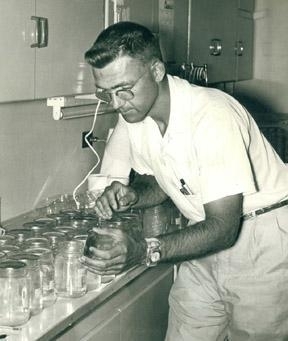
Winokur is testing “the use of hyperspectral imaging to differentiate between eggs collected from lab colonies of native and invasive Aedes mosquitoes in California. Preliminary data indicate this method shows promise for identifying species and warrants further testing. Once I have created species-specific reflectance profiles and validated my identification method using colony eggs, I will collect field eggs and validate the identification method using these field eggs.” She is working with hyperspectral imaging expert Christian Nansen, agricultural entomologist and assistant professor, UC Davis Department of Entomology and Nematology, on the project.
Winokur describes hyperspectral imaging as “a powerful tool that recognizes slight changes; therefore, we need to ensure that all samples are collected and conditioned the same way before testing. Samples must be imaged directly on the oviposition paper because exochorion cells are damaged by the ‘glue' the female uses to attach her eggs to the substrate; imaging removed eggs leads to inconsistent reflectance profiles. This method for rapidly identifying Aedes eggs will allow for quick response to the detection of invasive Aedes mosquitoes.”
Winokur is using the 2017 Hazeltine funds to improve identification of invasive Aedes mosquito eggs in California and to attend the 2017 American Society of Tropical Medicine and Hygiene conference. She is also the newly announced recipient of a 2018 Hazeltine Student Research Award for $3,094, this time to investigate Aedes aegypti immune response to Zika virus.
A native of Long Beach, Calif., Olivia grew up in Laguna Niguel, Calif., where she focused on science at the Dana Hills High School Health and Medical Occupations Academy. She received her bachelor's degree in 2015 from Cornell University, majoring in Interdisciplinary Studies and focusing on the environmental effects on human health. She enrolled in the UC Davis graduate program in 2016 as a Ph.D entomology student with a designated emphasis in the biology of vector-borne diseases. Earlier this year, Winokur received a three-year National Science Foundation Graduate Research Fellowship.
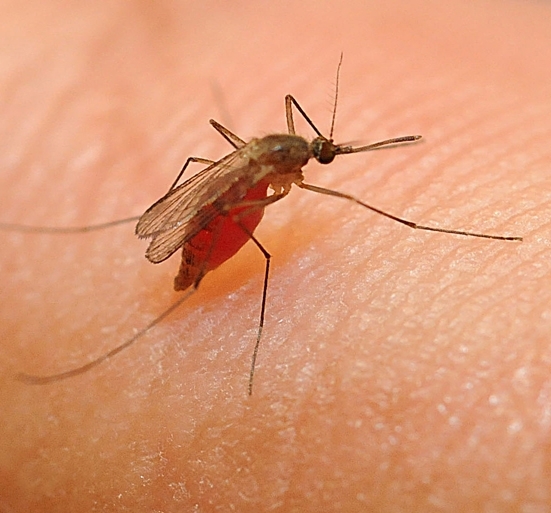
Maribel Portilla, currently writing her dissertation, said the three chapters will encompass: the management practices of the invasive exotic weeds, Brazilian waterweed (Egeria densa) and water hyacinth (Eichhornia crassipes), in the Sacramento-San Joaquin Delta and how those practices impact mosquitoes and their habitat; herbicide use in managing those weeds and how herbicides affects the larval habitat; and the direct effects of herbicides on larval mosquito development.
Her goal: “to inform and create better techniques to reduce both mosquito and weed problems."
Like Winokur, Portilla is grateful for the Hazeltine research funds. “I am currently exploring some molecular/genetic techniques (PCR and sequencing) to identify the species of mosquitoes I collected in the different weed/habitat mesocosms, This will be funded by the Hazeltine award I received.”
Portilla, who calls the South Bay home (San Martin, Santa Clara County), holds a master's degree in public health from UC Berkeley, where “I was able to study health and disease within a larger context, and learned to consider the biological and the social determinants of disease.” Her area of expertise incorporates her love for biology and her strong interest in social issues.
“At UC Berkeley School of Public Health, I was able to study health and disease within a larger context, and learned to consider the biological and the social determinants of disease. As I completed my degree, I realized I really missed the research experiences I had as an undergraduate. So, I looked for a way to bridge my new-found passion for public health and basic science research. This led me to UC Davis, where I learned about One Health and am now pursuing a Ph.D in medical entomology. Medical entomology is a perfect example of a One Health field, where I can seek out how interactions between humans and animals impact health. I am particularly interested in researching how disease risk may change as people manipulate the environment."
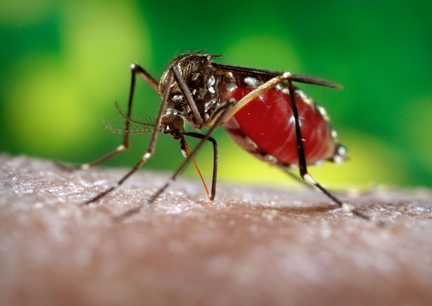
Her academic life revolves around writing her dissertation; teaching UC Davis classes (she's taught entomology, general biology and One Health classes); research; and public outreach. Since 2012, she has mentored some 30 undergraduate students on developing and executing their research experiments. She praised the “the diversity of my interns; they each brought such important and unique perspectives to the project.”
What are her career plans?
“Due to my diverse interests and skill set, I am very open about my career choices. I have extensive teaching experience, and would love to be a professor with both teaching and research opportunities. However, there are many opportunities beyond academia. My research is introducing me to many other ways in which my work and research can help keep people safe and healthy. I hope to develop a strong research skill set while at UC Davis, and find a career path which takes advantage of my diverse abilities and love for One Health and Public Health."
Portilla mentioned pursuing a career as a teacher in a small liberal arts school to teach public health, general biology and global diseases classes, as well as do outreach and research. “I'm more of a scientist than an entomologist,” she said.
Portilla may also pursue a career working in vector-control health education at the county, district or state level. “I'm open at this point,” she said. Overall, she is geared toward improving public health outcomes through healthier environments. “I care about how outcomes affect the larger population,” she said.

“Bill Hazeltine was an advocate for the use of mosquito control to protect people from mosquitoes and the disease agents they transmit, and he believed chemical control to be a necessary part of the means to accomplish this,” wrote Eldridge, who valued his friendship. “He also considered himself an environmentalist, and billed himself as such on his business cards and on his signature block. He had a vast knowledge of pesticides and pesticide legislation, and a strong belief in the scientific basis for public policy issues related to the safe and effective use of pesticides. Because the federal Endangered Species Act influenced mosquito control, he became an authority on this as well."
“After Bill's death, I was contacted by his sons about the possibility of establishing a William Hazeltine Memorial Scholarship Fund at UC Davis,” Eldridge noted. “They believed this would represent an important contribution because of Bill's strong interest and support of medical entomology research, and because of Bill's admiration of UC programs in mosquito control. The fund has grown to the point where graduate student awards can now be funded just from the interest, and a number of students at UCD have benefited from the thoughtfulness of the Hazeltine family.”
The list of recipients:
- 2018: Olivia Winokur (newly announced)
- 2017: Maribel "Mimi" Portilla and Olivia Winokur
- 2016: Sandy Olkowski, Maribel “Mimi” Portilla and Stephanie Kurniawan
- 2015: Sandy Olkowski, Maribel “Mimi” Portilla and Stephanie Kurniawan
- 2014: Martha Armijos, Elizabeth “Lizzy” Glennon and Rosanna Kwok
- 2013: Jenny Carlson, Elizabeth “Lizzy” Glennon and Sandy Olkowski
- 2012: Jenny Carlson, Kelly Liebman and Sandy Olkowski
- 2011: Brittany Nelms Mills, Kelly Liebman and Jenny Carlson
- 2010: Tara Thiemann and Jenny Carlson
- 2009: Kelly Liebman and Wei Xu
- 2008: Ashley Horton and Tara Thiemann
- 2007: Lisa Reimer and Jacklyn Wong
- 2006: Christopher Barker and Tania Morgan
- 2005: Nicole Mans
- 2004: Sharon Minnick
- 2003: Hannah Burrack
- 2002: Holly Ganz and Andradi Villalobos
- 2001: Laura Goddard and Linda Styer
- 2000: Laura Goddard
- 1999: Linda Boose Styer
- 1998: Larisa Vredevoe
- 1997: John Gimnig
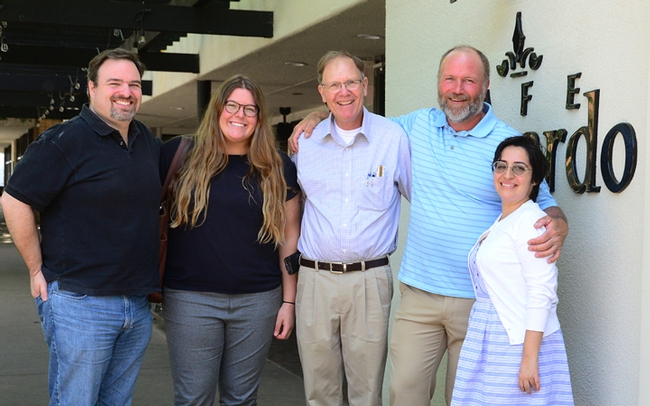
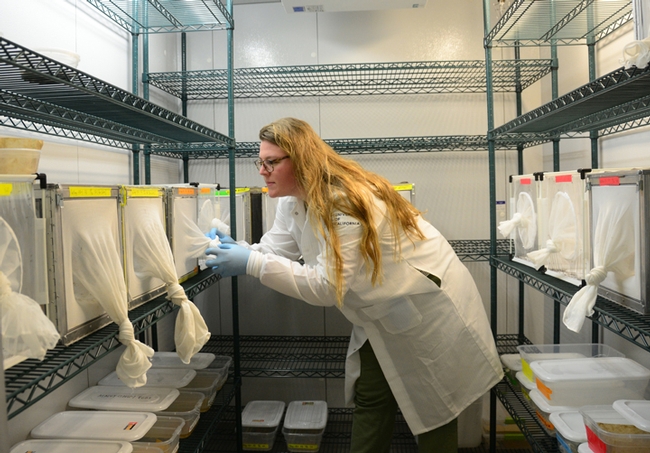
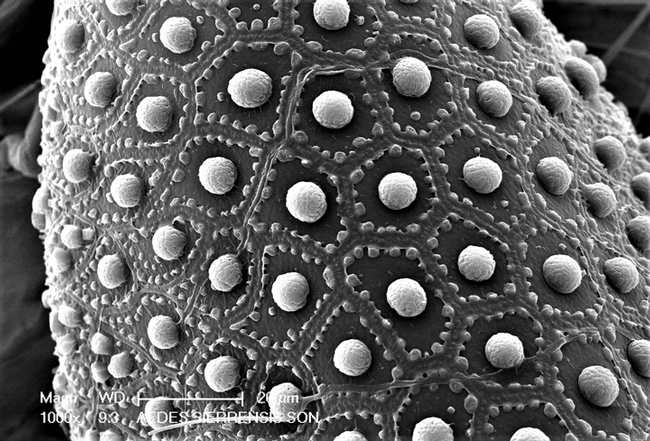
- Author: Kathy Keatley Garvey
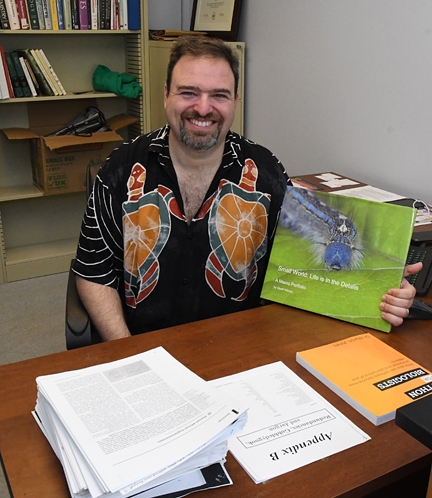
Attardo joined the department July 1 as an assistant professor after 13 years at the Yale University School of Public Health, New Haven, Conn., first as a postdoctoral fellow from 2004 to 2008, and then as associate research scientist and research scientist.
He now shares quarters in 37 Briggs Hall with Elina Lastro Niño, Extension apiculturist. Books on genes, genetics, genetic analysis, chemistry, biology and entomology line his book shelves, and macro images of insects and spiders brighten his walls. His coffee-table book, “Small World: Life Is in the Detail” showcases his passion for macro photography, particularly jumping spiders, dragonflies and praying mantids.
Geoffrey Attardo is eager to begin work. His research interests include the physiology and molecular biology of disease vectors, reproduction, nutrition, symbiosis, genetics, metabolomics, gene regulation, vector/parasite interactions “and any place the data leads me!”
“My lab will focus on aspects of the physiology of tsetse fly reproduction,” Attardo said. “The goal of this research is to identify and understand key aspects of tsetse's reproductive biology.” Tsetse flies, prevalent in much of sub-Saharan Africa, are known for vectoring human African trypanosomiasis, also known as sleeping sickness.
A native of Poughkeepsie, N.Y., Geoffrey received his bachelor's degree in entomology from the University of Massachusetts, Amherst, in 1994 and his doctorate in genetics from Michigan State University, East Lansing, in 2004.
A career in science came naturally. “My parents are both somewhat scientifically inclined, so I may have taken after them,” he says. “My father has a doctorate in metallurgy from Columbia University and led a long successful career at IBM. My mom was a full-time mom, but has a background in microbiology with a master's degree from Yale.”
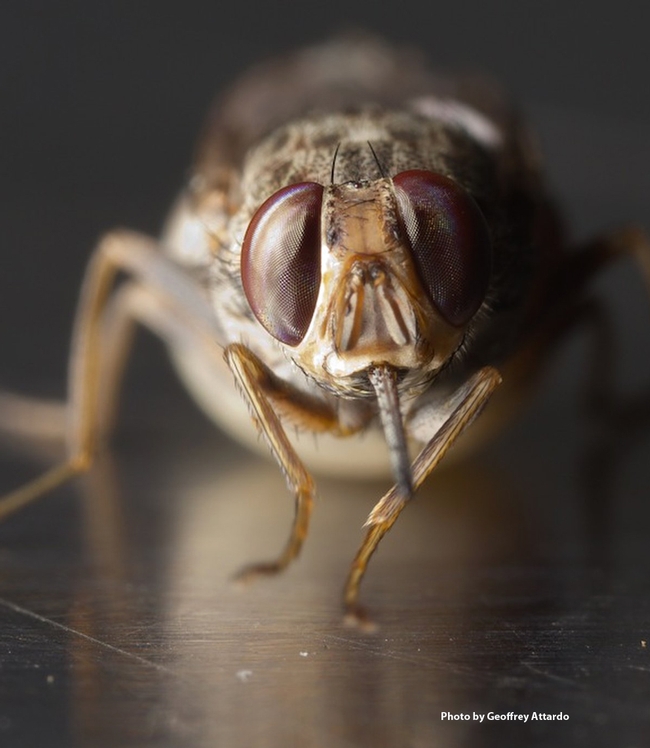
“I decided to develop my career in science and went to work in Dr. Alexander Raikhel's lab at Michigan State University as a graduate student. I was always drawn to understanding the molecular mechanisms underlying the extreme biology of insects and Dr. Raikhel's lab provided that opportunity. There I focused on the molecular biology of egg development in mosquitoes.”
In research on mosquitoes, Attardo demonstrated that mosquitoes require nutritional cues to begin egg development. “Egg development had been known to be regulated by a steroid hormone called 20-hydroxyecdysone,” Attardo explained. “However, treatment of mosquitoes with this hormone along did not activate egg development. My research showed that when female mosquitoes take blood, the protein in the blood is broken down into amino acids which in combination with the hormone activate egg development. Either amino acids or the hormone along were not capable of activating this process, but when they are combined it unlocks a massive physiological change which causes the production of yolk proteins and activation of egg development.”
After receiving his doctorate, Attardo joined the Yale lab of Serap Aksoy to work on tsetse flies. “In terms of fascinating physiological adaptations, the tsetse fly is one of the champions of the insect world!” Attardo says. “In addition to being vectors of a deadly disease, Trypanosomiasis, these flies have undergone amazing alterations to their physiology relative to other insects. Some examples of this are their ability feed exclusively on blood, their obligate relationship with a bacterial symbiont, the fact that they lactate and that they give birth to fully developed larval offspring. The opportunity to study the adaptations these flies have made is like opening a toy chest for an insect physiologist. My work in tsetse has focused on the molecular biology underlying the adaptations associated with the development of lactation, symbiosis, male and female mating interactions/physiology and nutrient metabolism and mobilization.”
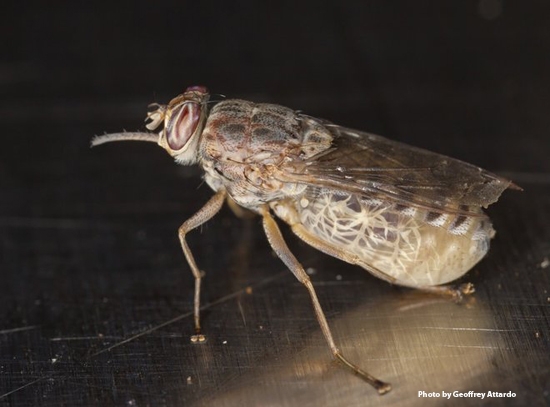
His tsetse research also includes identifying the tsetse milk proteins and the genes that code for them. Said Attardo: “They are really interesting as they are functionally very similar to milk proteins in mammals!”
In newly published research (June) in the Proceedings of the Royal Society B, he and his colleagues examined the relationship between the fly and its obligate symbiotic bacteria called Wigglesworthia. “Tsetse flies without their symbionts are unable to reproduce and abort their larvae before the complete development,” he says. “We showed that the bacteria supplements the flies diet with B vitamins and that the fly appears to scavenge nucleotides (the component molecules of DNA and RNA) made by the bacteria. The B-vitamins made by the bacteria enable the fly to metabolize nucleotides, sugars, amino acids and produce chemicals essential for its overall metabolism.”
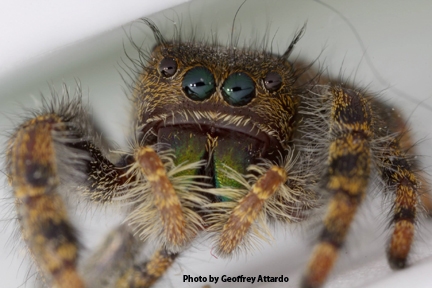
Attardo traces his interest in insects and macro photography to his childhood. “I had always been fascinated with insects, but my earliest memory was feeding insects to a beautiful black and yellow garden spider (Argiope aurantia) that had set up her web in front of the bay window of our house. I was especially interested in spiders. Another early memory was being sick in bed with the croup and reading--and rereading multiple times--through a picture book I had on spiders that had amazing macro photos. I found jumping spiders particularly fascinating. From that point on I had been fascinated with seeing insects up close, but it was not until I was able to afford a good digital camera and the appropriate lenses that I was able to get into insect photography.”
Attardo's first professional camera was a Canon that he received in the mid-1990s.
His first digital? A Canon Rebel XT. He now uses a Canon EOS 5D Mark IV with macro lenses, the MPE-65mm and the 100mm.
“I love macro photography because it reveals the amazing details that are present in things that many people take for granted or for mundane,” Attardo says. “Insects especially benefit from macro treatment as I find that most people have no idea about the type of amazing creatures they have living in their yard or even in their house. I'm often asked if my photos were taken in South America, Africa or Asia as the insects appear to be so exotic, however, they are often surprised --and sometimes dismayed--to find out that most of my photos are taken locally.”
The many shapes, sizes and designs of insects fascinate him. “I am a bit of a science fiction geek and I find insects to be almost alien in how different they are from vertebrates. It is like traveling to another planet when you start to magnify the world. I am endlessly fascinated with all the different strategies and adaptations they have developed to survive/thrive in places where many animals couldn't. I think by taking photos of them it allows me to open a window and share my fascination with people who don't normally give much consideration to insects and treat them just as bugs or an annoyance.”
“As a scientist, I have taken my fascination with the magnifying things to the extreme in that my work tends to focus on the molecular biology underlying the physiology of insect adaptations. The molecular adaptations are just as amazing as the morphological ones. However, they are even harder to visualize and explain to lay people. I enjoy illustration and artwork as well, so when it is not possible to take a picture of something I am working on, I try to create a visual representation of it.”
“I also really enjoy digital illustration and have recently gotten into 3D modeling. My first model is a tsetse fly for which I was able to use my macro photos to texture. See (https://sketchfab.com/models/263750e5a9c54c56a77d63ac06f2f317
He and his wife, Meg Gurley and their son, Douglas, 13, are settling into their home in Davis. "Meg is a full-time mom currently," he says, "and a Master Gardener. We have a symbiotic relationship as she grows the plants that attract the insects I like to photograph. Douglas and I are both into computers and computer gaming together."
Future lab plans? Attardo said three undergraduates will join his lab in the fall, helping him to “get the lab set up and running.” He hopes to hire a lab manager, a postdoc and “a couple of graduate students.”
A few of the projects he is excited to pursue:
- Study of lipid metabolism during tsetse pregnancy and the role that symbiotic bacteria play in this process.
- Understanding the molecular mechanisms that regulate the expression of genes coding for milk proteins during the lactation cycle.
- Understanding the physiology behind mating effects on female tsetse flies and the role of male seminal secretions on female fertility.
- Comparative genomic analysis of different tsetse species to identify factors associated with vectorial capacity.
- Understanding the nutritional and metabolic impact of trypanosome infection on female tsetse flies and their reproduction.
- Development of new non-invasive detection techniques to measure changing physiological states and determine trypanosome infection in flies using hyperspectral imaging.
Geoffrey Attardo invites “anyone who is interested in meeting me and talking science, photography or anything else to stop by the lab and visit! My door is always open--unless I have a grant due!”
He can be reached at gmattardo@ucdavis.edu.
